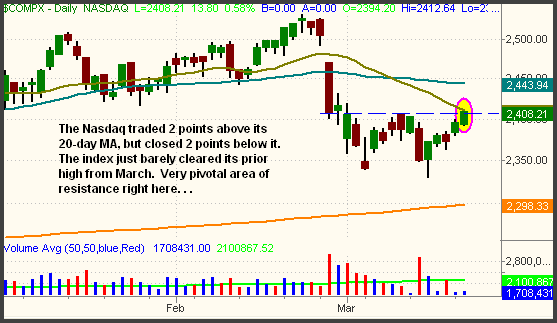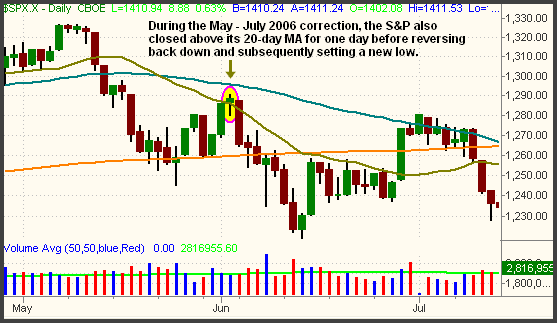| The Wagner Daily ETF Report for March 21 |
| By Deron Wagner |
Published
03/21/2007
|
Stocks
|
Unrated
|
|
|
|
The Wagner Daily ETF Report for March 21
The broad market followed through on Monday's gains yesterday, causing the major indices to test key resistance of their 20-day moving averages. After opening flat, stocks trended higher throughout the morning, pulled back slightly in the afternoon, then crawled back towards their highs in the final hour. Both the S&P 500 and Nasdaq Composite gained 0.6%, while the Dow Jones Industrial Average rallied 0.5%. The small-cap Russell 2000 and S&P Midcap 400 indices were each higher by 0.8%.
Can you guess what was once again missing from yesterday's rally? Disappointing turnover once again failed to confirm the gains. Total volume in the NYSE only declined by 1%, but remember that the previous day's level was already the second lightest day of the year. Volume in the Nasdaq increased 3% over the previous day's level, though it was still well below average. Most likely, we will begin to see the return of institutional trading activity after this afternoon's Fed announcement on interest rates. However, the big question is whether they will join the party and run stocks higher or sell into the strength of the short-term bounce. Market internals were solid yesterday, as advancing volume exceeded declining volume by a ratio of approximately 2.7 to 1 in both exchanges.
Yesterday, we discussed the likelihood of the major indices testing pivotal resistance of both their 20-day moving averages and their "swing highs" from earlier this month. We didn't need to wait too long, as the test came yesterday. The Nasdaq Composite probed 2 points above its 20-day MA on an intraday basis, but closed 2 points below it. The index also closed just above intraday resistance of its March high:

Similar to the Nasdaq, the Dow Jones Industrials traded 3 points above its 20-day MA yesterday, but finished 3 points below it. The Dow also has more overhead supply to contend with because it is still 60 points below its prior high from March 12:

Of the "big three" major indices, the S&P 500 was the only one that finished above its 20-day MA, albeit by only 3 points. The index also closed right at its prior high from March 9:

It's common for stocks and indices to close above their 20 or 50-day moving averages (in a downtrend) or below them (in an uptrend) for one or two days before reversing. Often, the resumption of the primary trend (down in this case) comes only after many investors are fooled into believing a trend reversal has occurred. Causing enough buying pressure for an index like the S&P to close above its 20-day MA for a day or two usually does the trick. As you might recall, this is what occurred during the broad market's last substantial correction from May - July of 2006. Take a look:

As you can see, the S&P 500 closed above its 20-day MA for exactly one day (June 2) before swiftly reversing and subsequently taking out its prior low. Obviously, it's impossible to know if this same scenario will occur again. However, the continuation of bearish price to volume patterns have increased the likelihood of another move lower before going much higher. Today should be very interesting because the major indices have run into their 20-day moving averages at the same time the Federal Reserve Board will be releasing their highly anticipated update on economic policy. We expect a strong and immediate reaction either way, as current levels are just too pivotal for there not to be.
Deron Wagner is the Founder and Head Trader of both Morpheus Capital LP, a U.S. hedge fund, and Morpheus Trading Group, a trader education firm launched in 2001 that provides daily technical analysis of the leading ETFs and stocks. For a free trial to the full version of The Wagner Daily or to learn about Wagner's other services, visit MorpheusTrading.com or send an e-mail to deron@morpheustrading.com.
|